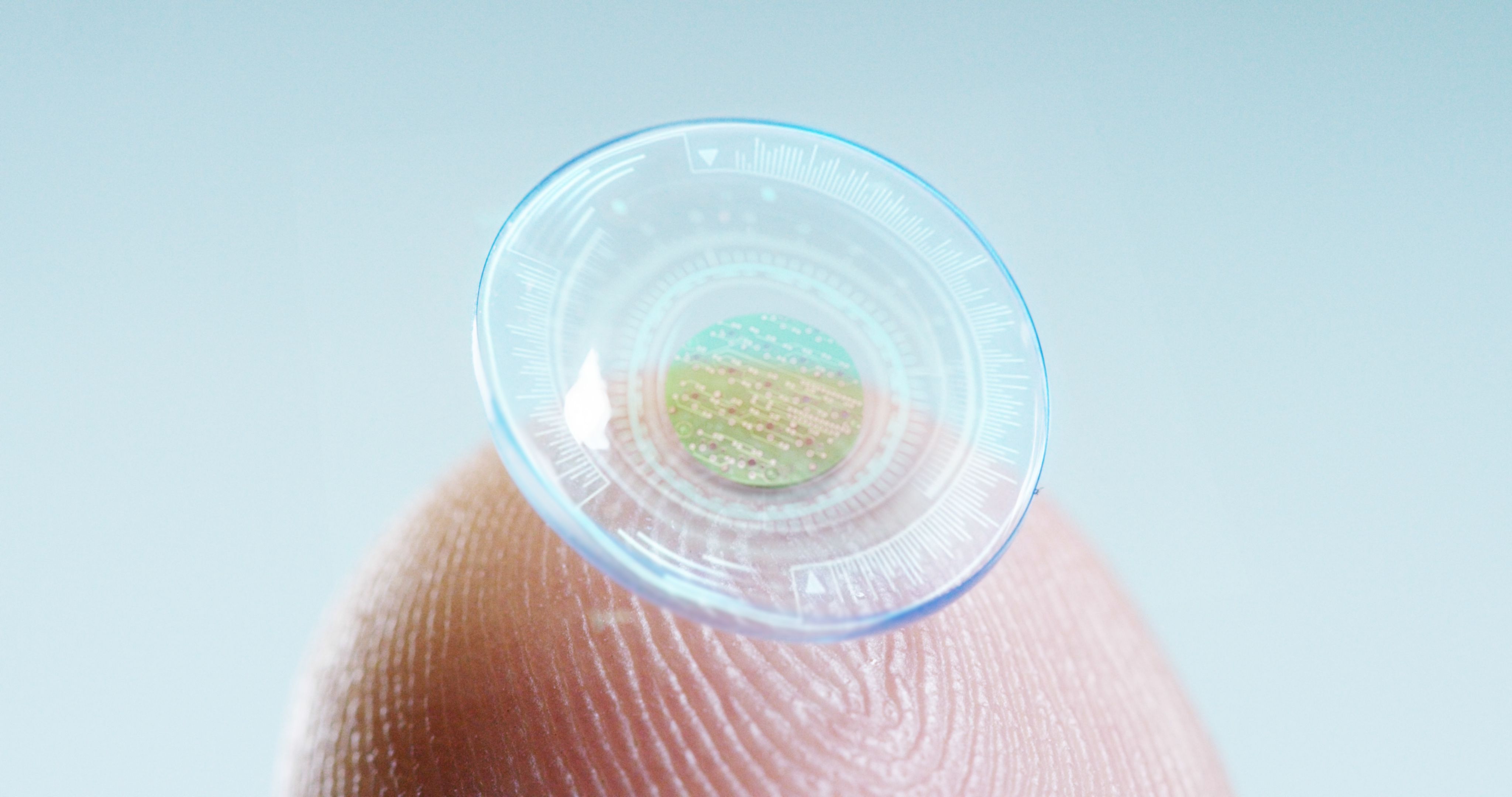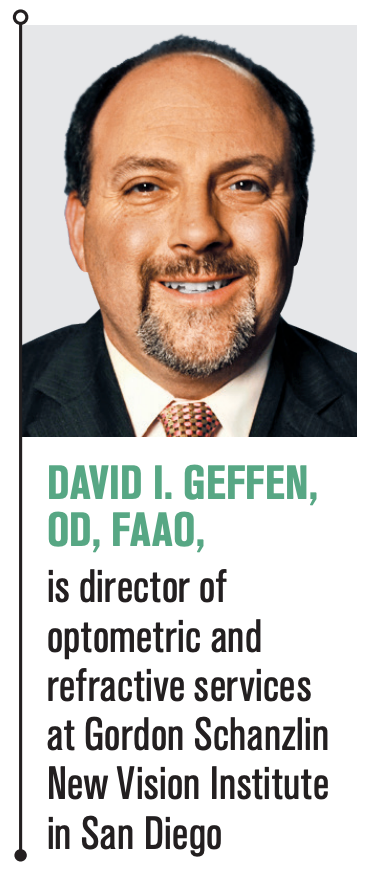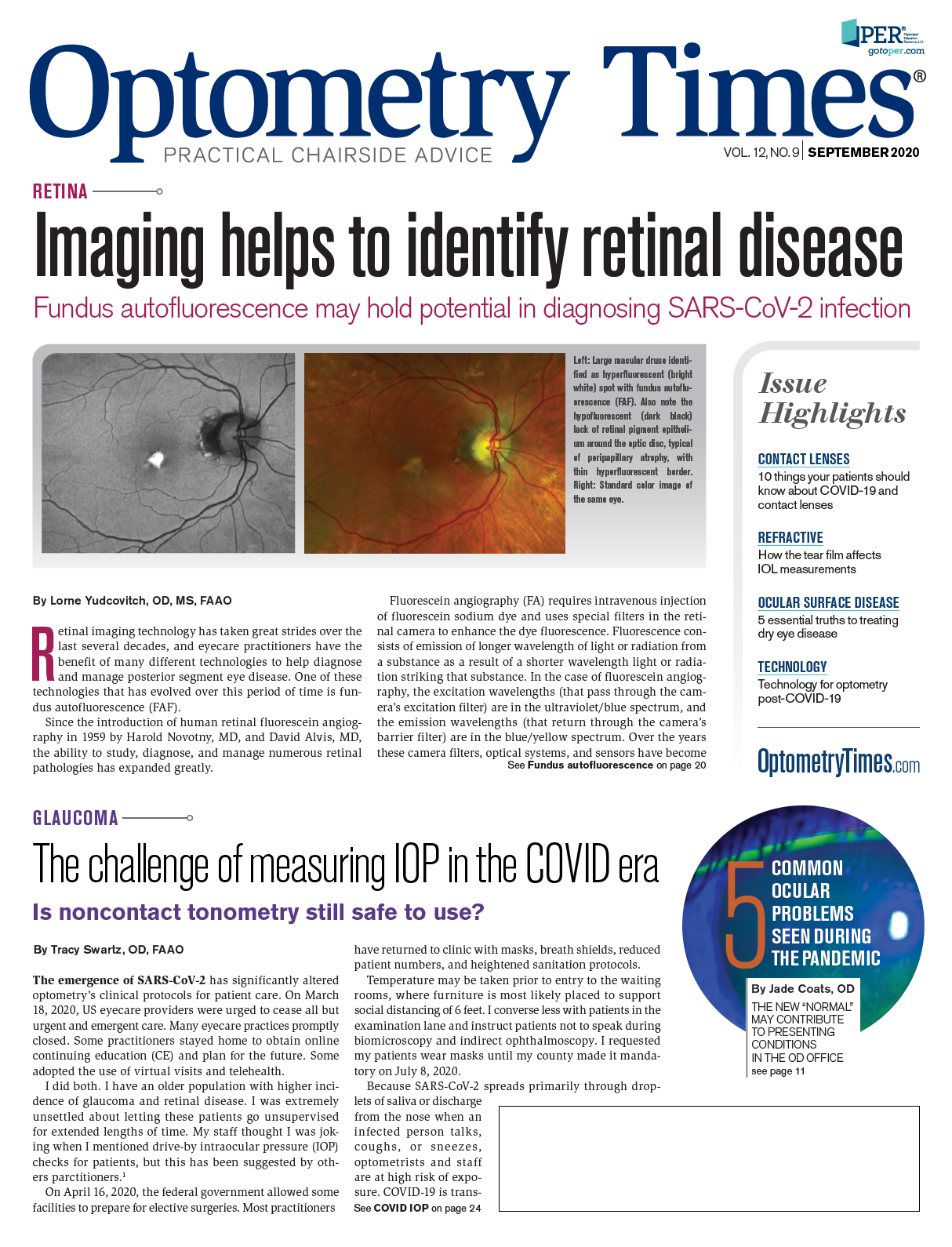Smart contact lens update
New devices will monitor health, enhance vision, and treat the eye


The companies behind smart contact lenses are staying quiet about their work, but we know that applications include health monitoring, medical treatment for allergy and burns, invisible computing and enhancing vision. The future of optometry includes the utilization of smart contact lenses for allergy, glaucoma, AMD, OSD, and more.
What is the IQ of a contact lens? Does the term “smart” contact lens mean the lens thinks? I went looking for a definition of the so-called “smart” contact lens and found a wide variety of meanings. But the one that I think sums up the best overall definition is this: “A smart contact lens means putting rigid, non-see-through components onto a lens that will be in direct contact with the eye.”1
Smart contact lenses can act as medical devices, health trackers or gauges, and audio and video recorders. In addition, the possibility is being explored of using smart contact lenses to perform as a computer.
I next went on a mission to discover the status of these “intelligent” lenses. The mission was difficult because most companies are in stealth mode with these lenses and are not willing to share information about them. Searching patents and business literature proved to be the best sources to get a picture of this young industry and allows ODs to get a glimpse of what is coming to their practices.
Smart contact lenses fall into a few categories. Some are for medically treating the eye, some act as monitors for various health functions, and some are for enhancing vision.
Let’s look at the candidates by category.
Medical treatment
Johnson & Johnson Vision has Phase 3 data on an antihistamine-releasing contact lens. This lens could be used to decrease the symptoms of common allergic conjunctivitis. The company’s etafilcon A lens material is combined with a small amount of ketotifen, a known antihistamine.2
Researchers at the University of New Hampshire have developed a new hydrogel material which may be used to treat severe corneal injuries such as chemical burns and auto-immune disease. This lens material works by reducing the matrix metalloproteinases (MMP) produced in these traumatized corneas via eliminating the zinc ions released due to these diseases.3
Leo Lens has been working on new drug delivery systems utilizing contact lens materials. The company incorporates its patented technology with high-tech digital printing to produce a drug-eluting contact lens to continuously deliver the drug over 7 days. The company’s first product will target glaucoma.4
Queensland University of Technology is developing a new therapeutic contact lens that acts as a bandage for ocular surface injuries. The bandage contains limbal mesenchymal stroma cells attached to the inner surface of the contact lens. This could be a valuable treatment in injuries such as chemical burns and heat injuries.5
OcuMedic is developing a contact lens for drug delivery to the eye. The company’s patented technology creates a new architecture with memory for the drug within the polymeric network comprising the lens to enable continuous release of drugs to the eye. Various drug may be used with the lens. OcuMedics’ lead product targets pre- and post-cataract surgery, laser in-situ keratomileusis (LASIK), and corneal abrasions. The early drugs added to the lens are the anti-inflammatory bromfenac (Xibrom, Prolensa; Bausch + Lomb) and antibiotic moxifloxacin (Vigamox, Moxeza; Alcon).6
Health monitor
Triggerfish was one of the first smart contact lenses in the industry. This lens received U.S. Food and Drug Administration (FDA) approval in 2016. The lens helps monitor intraocular pressure (IOP) to help in the treatment of glaucoma. It provides 24-hour monitoring of a glaucoma patient via an embedded strain gauge to measure corneal radius of curvature as it fluctuates with pressure within the eye. Triggerfish does not measure IOP per se; it measures distension of the eye with pressure and produces output in millivolts. To date, the device has not received widespread use.7
Enhance vision
Researchers at the University of California San Diego and the Harbin Institute of Technology in China have developed a biomimetic soft contact lens that can zoom in and out simply by the user blinking. They have not yet produced a wearable prototype but are hoping to get there soon.8
An international collaboration of scientists has created a contact lens which can shift between magnified and normal vision. This could be an advantage to patients with decreased vision, especially age-relate macular degeneration (AMD). The lens works by incorporating tightly fitting mirror surfaces into a telescope a millimeter thick that fits within the contact lens. The telescope can magnify about 2.8 times magnification. It must be used with a pair of polarized glasses which can block the magnified or normal area.9
Lenses with pliable, transparent electronics can measure glucose levels from tears in the eyes and warn the individual when levels are too high. The electronic components are 1/100 the thickness of the lens and invisible to the wearer. This could be a valuable benefit to the many diabetics ODs treat.10 In 2014, Alcon partnered with Google to create a glucose-sensing contact lens; however, the companies announced about 4 years later they had ceased work on the project.11
Innovega has developed a contact lens embedded with tiny optical components and a filter. The contact lens combines with a pair of glasses, creating a heads-up display which allows the wearer to see normal things as well as streaming video or other augmented reality visions. The system, known as iOptik, was initially developed for military use; the company is working on a consumer device.12
InWith Corporation has partnered with Bausch + Lomb to create an augmented reality contact lens. The lens is embedded with a microchip which sends alerts and notifictions to a smart phone, and the power is obtained by harvesting energy from the natural blink process of the eyes. There is potential to analyze tears for blood chemistry that could monitor blood sugar, cancer, and virus detection and monitor artificial organ parts with electronics for movement.13
Mojo Vision’s Mojo Lens features a built-in display that gives people useful and timely information without forcing them to look down at a screen. This scleral lens is designed to provide real-time contrast and lighting enhancements as well as zoom functionality. It could serve as a low-vision aid to magnify the world for those with reduced acuity. For business use, it can give realtime heads-up displays to enhance productivity and efficiency. It contains a tiny 14K-ppi microLED display, which is the smallest and densest display developed.14
Conclusion
Smart contact lenses may sound like science fiction, but ODs and consumers are seeing a race among researchers to develop lenses to perform a wide variety of functions to improve our lives. This article gives just a small flavor of what is being worked on in the world. Many more designs are being developed, but the companies will not reveal much information. One thing is certain: optometrists will be utilizing many of these lenses in their practices. Optometry will need to be partners in getting these lenses into the marketplace.
References
1. Best Jo. How smart contact lenses will help keep an eye on your health. ZDNet. Available at: https://www.zdnet.com/ article/how-smart-contact-lenses-will-help-keep-an-eye-onyour-health/. Accessed 9/1/20.
2. Hale C. J&J’s antihistamine-eluting contact lenses clear phase 3 allergy studies. Available at: https://www. fiercebiotech.com/medtech/j-j-s-antihistamine-elutingcontact-lenses-clear-phase-3-allergy-studies. Accessed 9/1/20.
3. University of New Hampshire. UNH Researcher Create a Hydrogel Contact Lens to Treat Serious Eye Disease. Available at: https://www.unh.edu/unhtoday/news/ release/2019/03/12/unh-researchers-create-hydrogelcontact-lens-treat-serious-eye-disease. Accessed 9/1/20.
4. Invision Staff. Leo Lens Technology Selected as Finalist for Connect’s 2019 Most Innovative New Product Awards. Available at: https://invisionmag.com/leo-lens-technologyselected-as-finalist-for-connects-2019-most-innovative-newproduct-awards/. Accessed 9/1/20.
5. Queensland University of Technology. New Contact Lens to Treat Eye Injuries. Medical Xpress. Available at: https:// medicalxpress.com/news/2018-11-contact-lens-eye-injuries. html. Accessed 9/2/20.
6. OcuMedic, Inc. White Paper. Available at: http:// secureservercdn.net/198.71.233.106/o5u.594.myftpupload. com/wp-content/uploads/2019/09/OcuMedic-TechnologyWHITE-PAPER-July-2018.pdf. Accessed 9/2/20.
7. Harrison L. Triggerfish pressure sensor promising. Ophthalmology Times. Available at: https://www. ophthalmologytimes.com/view/triggerfish-pressure-sensorpromising. Accessed 9/1/20.
8. MedGadget Editors. Smart Contact Lens Zooms On Demand. Available at: https://www.medgadget.com/2019/07/ smart-contact-lens-zooms-on-demand.html. Accessed 9/2/20.
9. Berboucha M. First Ever Switchable Telescopic Contact Lens. Forbes. Available at: https://www.forbes.com/sites/ meriameberboucha/2018/02/28/first-ever-switchabletelescopic-contact-lens/#1e326b246ec4. Accessed 9/1/20.
10. Service RF. These smart contacts can monitor the glucose in tears. Science. Available at: https://www.sciencemag.org/ news/2018/01/these-smart-contacts-can-monitor-glucosetears#. Accessed 9/1/20.
11. Verily. Update on our Smart Lens program with Alcon. Available at: https://blog.verily.com/2018/11/update-on-oursmart-lens-program-with.html. Accessed 9/2/20.
12. Robertson A. Innovega combines glasses and contact lenses for an unusual take on augmented reality. The Verge. Available at: https://www.theverge. com/2013/1/10/3863550/innovega-augmented-realityglasses-contacts-hands-on. Accessed 9/1/20.
13. Fink C. InWith Puts Smart Tech In Bausch and Lomb Lenses. Forbes. Available at: https://www.forbes.com/sites/ charliefink/2020/03/09/inwith-puts-smart-tech-in-bauschand-lomb-lenses/#53ee17b796ac. Accessed 9/1/20.
14. Mojo Vision Developing First True Smart Contact Lens. Available at: https://www.businesswire.com/news/ home/20200116005221/en/Mojo-Vision-Developing-TrueSmart-Contact-Lens. Accessed 9/2/20.

Newsletter
Want more insights like this? Subscribe to Optometry Times and get clinical pearls and practice tips delivered straight to your inbox.